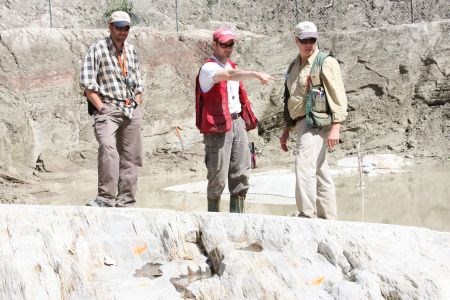Scott Jobin-Bevans of Treasury Metals believes the Dryden area will someday be on par, and have the same longevity, as any of the major gold camps in Northern Ontario.
Like many places in northwestern Ontario, the Kenora district has been an overlooked area of exploration, despite a storied mining history dating back to the turn of the last century.
“It’s almost developed an air of indifference much like Sudbury in the late 1990s,” said Jobin-Bevans, company president and geologist, “when everyone assumed everything had been found because Inco and Falconbridge were there.”
The Toronto junior has assembled a 53-square-kilometre land package, cobbled together through staking and acquisitions from Corona Gold, Teck Resources and Laramide Resources to create its Goliath Gold Project, about 20 kilometres east of Dryden.
The Dryden area was never considered an exotic camp, like nearby Red Lake, because the Wabigoon geology was always considered high grade but was believed to yield only small pockets of gold. Compared to other greenstone belts, the district has only produced a paltry 250,000 ounces, all of it mined before the Second World War.
But Jobin-Bevans knew of the area’s unlimited potential dating back to his days with the Ontario Geological Survey in the early 1990s.
Just north of the Trans-Canada Highway is its Thunder Lake deposit, where the company has embarked on a 20,000-metre drill program this winter to prove up resources of close to a million ounces of gold with an inferred resources average grade of 2.7 grams per tonne.
At Goliath, they’ve identified the district’s largest gold resource with an indicated resource of 3.4 million tonnes (270,000 ounces) and an inferred resource of 10.6 million tonnes (930,000 ounces)
This year’s goals are all about building and upgrading ounces, and testing for new targets in exploring a trend of mineralization to the northeast.
Armed with a positive preliminary economic assessment (PEA), Treasury has moved fast since 2007 in steadily advancing Thunder Lake toward the pre-feasibility stage with plans to build an open pit and underground mine, and a milling operation.
A potential mine would require $76 million in initial capital spending with a life-of- mine expenditure of $117 million.
The PEA said 390,000 ounces can be recovered over 8.5 years at a production rate of 1,500 tonnes per day, with an annual recovery of 48,000 ounces of gold.
Jobin-Bevans expects an updated resource estimate and economic model will be out by March or April.
Next fall, the company will be opening up a 275-metre decline, originally driven by Teck- Corona in the late 1990s, to do some underground drilling and test mining as they move toward feasibility.
As their name implies, Treasury is well stocked with cash thanks to an annual royalty from a Mexican gold mine, but Jobin- Bevans isn’t ruling out sharing the costs if the right partner comes along.
“We’re still very much hanging back. We’re off the radar for a lot of people.
“If we go toward production, then we’ll make a decision on whether we take most of the equity or do a debt-financing sale on the back of gold production.”
Heading into development, Jobin-Bevans said their approach is to start with a small project, gradually build up their ounces, and start the cash flowing within two to three years with just equity financing.
While the Kenora district contains a breadbasket of precious and base metals, including rare earth minerals, high-grade gold remains the focus of several active juniors.
There are close to 20 active juniors working “sweet little targets” within a two- to three-hour drive of Dryden, said Jobin-Bevans, including Treasury’s grassroots Goldcliff Gold Project, 40 kilometres southeast of Dryden.
The company has a concept to consolidate their gold operations with a milling facility near Dryden.
“I think there’s an opportunity to aggregate several million ounces very quickly once you demonstrate you can get that initial mill built and deposit going.”
Klohn Cripper Berger is handling Treasury’s environmental baseline study and Kelowna’s Distinctive Drilling has been contracted for the exploration program, but Treasury wants to use local labour wherever possible and is willing to help train line cutters and drill helpers.
Some of that workforce may come from the Eagle Lake and Wabigoon First Nations with whom Treasury wants to sign a formal Memorandum of Understanding agreement.
“We believe the MOUs will be the next step forward as part of the pre-feasibility,” said Jobin-Bevans.
www.treasurymetals.com




